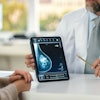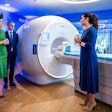
Giving radiologists information about the importance of disinfection and sanitization practices at the workstation prompted them to clean their work areas more often, according to the results of a Canadian study. The researchers believe the findings offer hope for reducing bacterial contamination in the workplace.
Dr. Jeff Quon, a fourth-year radiology resident at the University of Ottawa in Ontario, said he was motivated to look at disinfection practices at his hospital after reviewing the literature on the topic, in particular the results of a study on bacterial contamination in the reading room that he found "distressing."
"There was significantly more [bacterial] colonization of microphones and computer mice at [radiologist] workstations than of bathroom toilet seats," Quon said of the previous research. "It is really up to the individual radiologist to disinfect daily."
He presented the results of his study at the 2015 Joint Congress on Medical Imaging and Radiation Sciences, which brought together the Canadian Association of Radiologists (CAR) and the Canadian Association of Medical Radiation Technologists (CAMRT), as well as two French-language associations based in Quebec representing radiologists and radiation technologists.
Quantifying bacterial contamination
Quon and a co-investigator sought to evaluate disinfection practices at their hospital, looking at workstation disinfection rates and the hand hygiene habits of radiology personnel. The impetus for the investigation was a 2013 study by Duszak et al on the cleanliness of radiology workstations that was published in the Journal of the American College of Radiology.
That study quantified bacterial contamination at radiologist workstations by swabbing dictation microphones and computer mice in inpatient and outpatient reading rooms at two teaching hospitals in two states. The group found that 64.3% of workstation sites had evidence of Staphylococcus aureus and 21.4% showed signs of enteric organisms. Microphone and mouse bacterial contamination was significantly greater than that of nearby washroom toilets and doorknobs, but brief antiseptic swabbing almost completely eradicated the bacterial counts.
For their study, Quon and his research partner developed a 10-question Internet survey in January 2014 to assess hand hygiene and disinfection routines among radiologists, fellows, and radiology residents. The participants received the survey once, before being educated about disinfection and hygiene practices, followed by a similar follow-up survey.
The survey asked respondents the following:
- How often in the past four weeks they had disinfected their workstation
- What components of the workstation were disinfected
- If disinfectant swipes are available near their workstation
- If they regularly wash their hands before working at their workstation
- If they regularly wash their hands after working at their workstation
- If they regularly eat or drink at their workstation
- If they were more likely to disinfect their workstation during cold/flu season
- If hand sanitizer stations are accessible near their workstation
- If they have received instruction on how to properly disinfect their workstation
After the initial baseline survey, participants were emailed a presentation about the importance of and proper techniques for workstation disinfection, highlighting the equipment they should disinfect, including the Dictaphone, keyboard mouse, telephone, desk surface, and computer monitor handles.
In addition, placards were placed at each workstation, reminding radiologists to disinfect their work area daily. After clinicians received the education and were exposed to the placards for six weeks, the second survey was administered to see if the participants had changed their disinfection practices.
In the baseline survey, all 84 respondents said they had never received instruction on how to disinfect their workstation. Almost all (98%) said they routinely drink water, tea, or coffee at their workstation, and nearly half (46%) said they eat lunch at their workstation.
A total of 54% said they disinfect their workstation at least once per week, and the balance (46%) said they disinfect their workstation less than once per week or never. Less than half (42%) said they wash their hands before working at the workstation, and half (50%) said they wash their hands after working at the workstation.
But there was an improvement in disinfection practices after the educational initiative, as noted in the second survey, which included 74 respondents. The number of respondents who disinfected their workstation at least once per week rose 20 percentage points, to 74% (p = 0.01), and the number who disinfected their workstation less than once weekly fell 20 percentage points, to 26% (p = 0.01).
On the other hand, the practice of hand washing/using hand sanitizer before or after working at the workstation did not change significantly. Respondents were not asked in the second audit about their consumption habits.
"Ideally, people are washing their hands before and after working at their workstation," Quon said in an interview. "They can spread bacteria to other workstations if they do not wash their hands and they are working at a contaminated workstation."



















